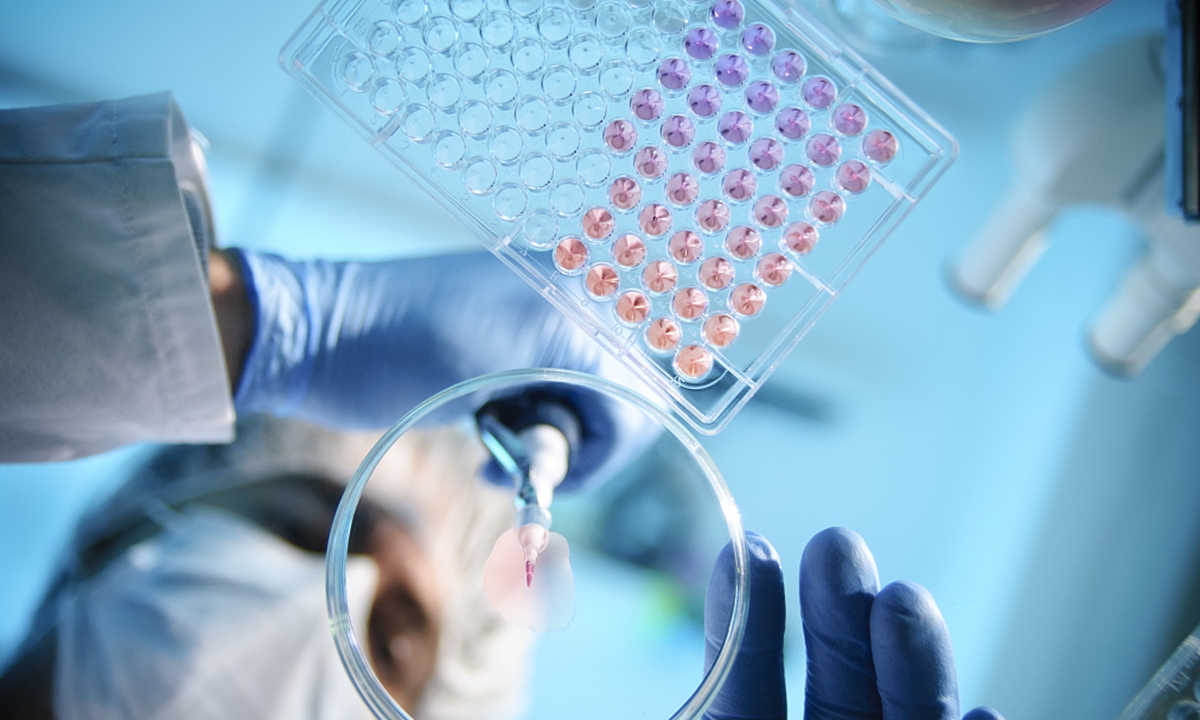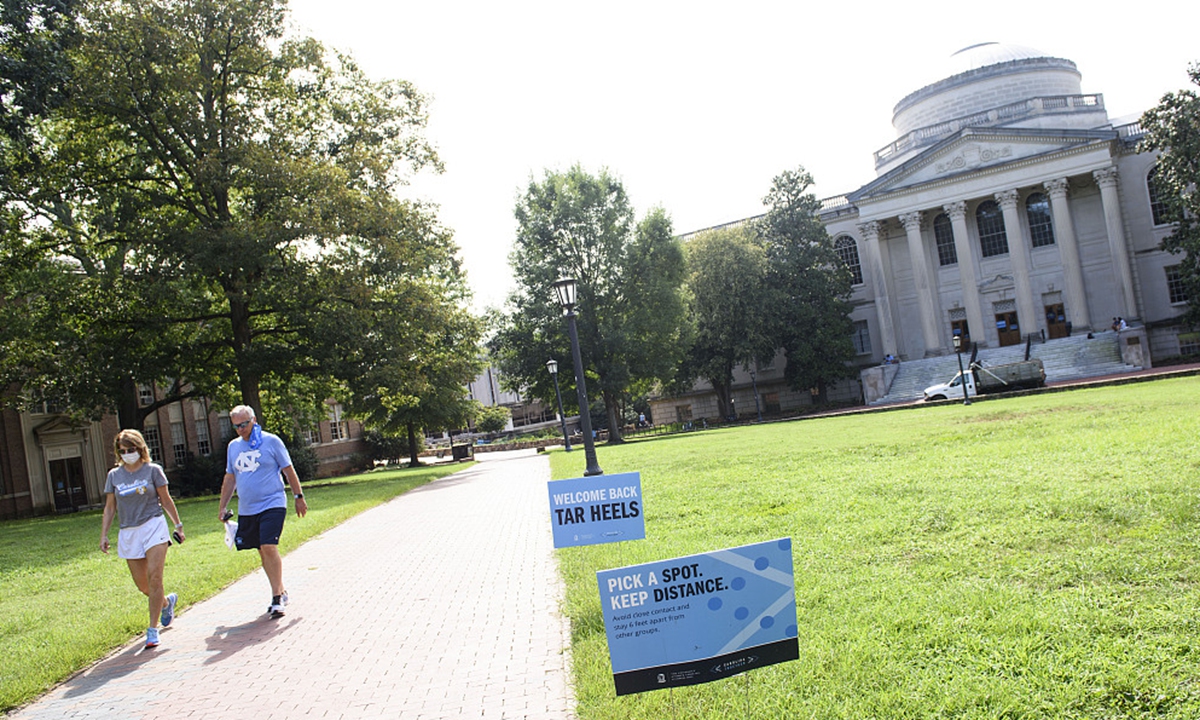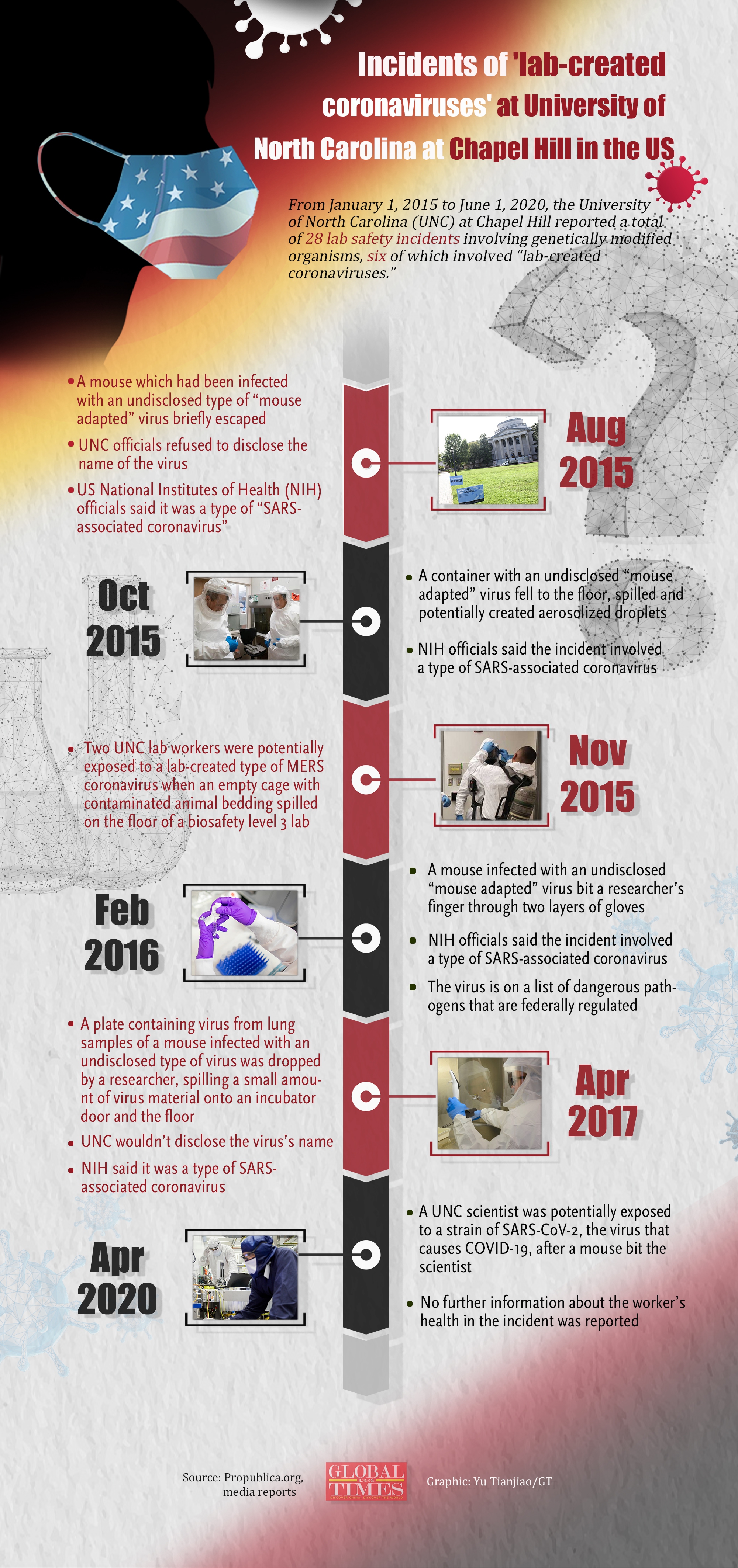
Photo: VCG
Alongside the infamous Fort Detrick lab, a biological laboratory at the University of North Carolina (UNC) at Chapel Hill, led by well-known US coronavirus expert Ralph Baric, has become the focus of public suspicion in the search for the origins of COVID-19, with many observers pointing to its poor safety record and unwillingness of researchers to speak publicly.
Ralph Baric’s team is the authority when it comes to [coronavirus] research, with widely recognized capability in synergizing and modifying coronaviruses, said Chinese Foreign Ministry spokesperson Zhao Lijian, urging the US to invite World Health Organization (WHO) experts to investigate the UNC facility. “A probe into Baric's team and lab would clarify whether coronavirus research has created or will create SARS-CoV-2,” Zhao said during a press conference in late July.
The international community clearly views the US, which has been hyping up the “lab-leak theory” and engaging in groundless attacks against China, as a major suspect responsible for leaking COVID-19, one insider told the Global Times.
With a more [mature] environment of lab virus synthesizing and operating, as well as virus leakage cases in history, the COVID-19 was obviously more likely leaked from the US labs if the lab-leak claim is true, said a Chinese biosecurity specialist surnamed Li (pseudonym), who works at a research institute affiliated with the Chinese Academy of Sciences.
“We appeal to the WHO to put US labs, including the one located at UNC, into its second phase investigation,” Li told the Global Times.
Frequent lab-created accidentsSimilar to the Fort Detrick lab, the public has found that high-security labs at UNC have developed a reputation for their frequent accidents, attributed to lax safety procedures. The lab at UNC-Chapel Hill reported 28 lab incidents involving genetically engineered organisms to officials at the US National Institutes of Health (NIH) from January 2016 to June 2020, according to ProPublica, a nonprofit news website based in New York City.
Six of the incidents involved “various types of lab-created coronaviruses,” according to an article published by ProPublica on August 2020. “Many were engineered to allow the study of the virus in mice,” it added.
The six coronavirus-related accidents reported by UNC were filled with basic errors and incorrect remedial measures, the Global Times found.
In August 2015, for instance, a mouse that had been infected with an undisclosed type of “mouse adapted” virus squirmed free of a researcher’s gloved hand and onto the lab floor. NIH officials told ProPublica it was a type of “SARS-associated coronavirus.” Workers involved in the incident were asked to report their temperatures and any symptoms for 10 consecutive days.
In April 2020, a mouse flipped over in a researcher’s hand and bit an index finger through two layers of gloves. The mouse bite caused potential exposure to a strain of SARS-CoV-2, which had been adapted for growth in mice, the UNC report said. Nonetheless, instead of being placed into medical quarantine, the researcher only undertook 14 days of self-isolation at home.
It was more likely that UNC labs inadvertently leaked virus through the accidents which infected humans, although the possibility was theoretically small, Li said.
“A single incident like the UNC reported could hardly cause immediate virus evolution or wide spread,” Li told the Global Times, “but there is possibility that the leakage has led to a modified virus spread among humans – potential up to several hundred of people – through a period of time, and that the virus evolves during human-to-human or human-to-animal transmissions.”

University of North Carolina (UNC) at Chapel Hil Photo: VCG
Opaque US biosecurity systemUNC lab accidents are only a tip of the iceberg when it comes to the US’ porous biological labs system. In 2015, a USA Today investigation revealed “hundreds of lab mistakes safety violations and near-miss incidents” that have occurred in biological laboratories coast to coast in recent years, which put “scientists, their colleagues and sometimes even the public at risk.”
Several Chinese virologists and biologists who had dealt with their US peers shared their concerns over the US’ non-transparent biosecurity system, which, as was noted by many, lacked adequate information reporting and supervision mechanisms.
Some US labs preserve samples of the viruses they uncover instead of reporting them, said Yang Zhanqiu, a virologist at Wuhan University. “Some samples are even held for decades,” Yang told the Global Times.
The lack of bottom-up messaging is also a big problem, noted Li. Usually front-line labs carrying out confidential or sophisticated biotechnology projects won’t be punished if they don’t report, or only report part of the whole story with upper-level acquiescence or ignorance, Li said. “That’s why the US government or even the president occasionally just say ‘I don’t know’ in responding to media and the public’s enquiries – they indeed don’t know what is exactly going on [at front-line labs],” he added.
For the six coronavirus-related incidents at UNC labs, the university declined to answer questions about the incidents or disclose key details to the public, including the names of viruses involved, the nature of the modifications made to them, and what risks were posed to the public, ProPublic said, noting this was “contrary to NIH guidelines.”
UNC has seemingly paid no price for its reticence. Numerous similar cases have exposed supervision loopholes in biosecurity system, some insiders have noted, warning that it may lead to a few US individual researchers or labs “do whatever they want.”
At University of Iowa, scientist Stanley Perlman launched work for the deadly MERS virus without faculty approval, the Des Moines Register reported in December 2014. Worse still, Perlman’s team conducted the MERS research in a biosafety level-2 lab, instead of a level-3 facility as is required by federal regulators, it said.
The university was also accused of “improperly withholding forms” that would allow the public to assess “whether any of the deadly agent imported from a collaborator in Spain was stolen, lost or released,” according to Des Moines Register.
Li, who has personally dealt with US experts, told the Global Times that although the US government’s policies in biosecurity seem cautious and mild, a few individual researchers (often with military connections) at front-line labs without foreign technical verification are “innovative, open and audacious,” he said.
Considering the leading biotechnology posture of US and an intentional ignorance of government departments, Li thinks there is the possibility that individual researchers or teams in the US may have, for example based on its considerable collection of coronavirus strains, secretly modified a virus precursor like COVID-19 without permission. “We can’t simply rule it out.”
Double standards against ChinaIn the US, there are lots of biobanks covering a number of industries including agriculture and energy, contributing to a huge sample database that China doesn’t have, said insiders reached by the Global Times.
No one can guarantee that the US biobanks are 100-percent safe and are subject to effective supervision, they noted.
With a mixed record on safety, the US’ ambiguous, double-standard attitude toward the COVID-19 lab leak theory has led many in the public to become increasingly suspicious: it keeps smearing Chinese labs for “leaking the virus,” while attempting to cover up its domestic situation.
Anthony Fauci, a top US expert in public health, was previously criticized by people in and out of the US for being inconsistent on the lab leak theory. Fauci rejected the claim in July, which contradicted his earlier statements such as “not convinced COVID-19 developed naturally” and calling for more investigations focused on Chinese labs.
Coronavirus expert Baric, whose team reportedly have refuted the lab leak theory though, told Spanish media that some man-made viruses can be “disguised” as coming from nature through techniques, and even implied that files at Wuhan Institute of Virology (WIV) have the answers people want.
Baric was also among the scientists who jointly wrote a letter in May to criticize the WHO’s investigation into the virus’ origins, which had ruled lab release in Wuhan “extremely unlikely.” “A rigorous investigation would have reviewed the biosafety level under which bat coronavirus research was conducted at WIV,” NBC quoted Baric as saying in June.
Ironically, while slandering Chinese labs using the lableak claim, the US keeps suppressing the voices that are calling for investigations on its own labs. After
Peter Daszak, a British zoologist who had been to Wuhan as a WHO expert team member, condemned The New York Times for engaging in selectively misquoting WHO experts to fit its own narrative, he was defamed by Western media and found his funding cut-off.
Australian virologist Danielle Anderson, the only foreign scientist to have worked in the high-security BSL-4 lab at the WIV, was threatened by a few extreme conspiracy theorists for defending WIV and refuting the lab leak saying. She had to call the police and lock down running app for safety reasons, Sydney Morning Herald reported in June.
Western social media platforms also helped to shut down those who raise legitimate questions about US labs, the Global Times found. “Greg Rubini” for example, a Twitter account that US government claimed is owned by a right-wing conspiracy theorist, was suspended after posting tweets that accused the US labs including the ones at the UNC of leaking the COVID-19.
Driven by the political need to smear and suppress others, the US has been busy muddying the waters, engaged in stigmatization, and turning COVID-19 origins-tracing study into a political weapon, Zhao said on Friday.
The US “has made lying, vilifying and coercing its standard operating practice without any respect for facts, science or justice,” FM spokesperson Zhao said. “Such despicable behavior will leave a stain in the history of the humanity's fight against diseases.”

With records of “lab-created coronaviruses” incidents, supervision loopholes and audacious germ researchers, labs led by Ralph Baric at UNC-Chapel Hill have become focus of public suspicion in the search for virusorigins.






